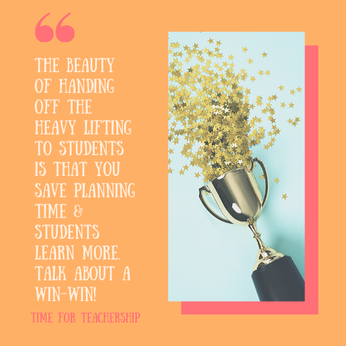|
Student-centered learning, personalized learning, and all of the other buzzwords can get a little confusing. Or they sound great in theory, but just aren’t easy to put into action. In this post, we’re digging into what it means for students to “do the heavy lifting,” but we’re also going to talk about why it’s in both your and your students’ best interests for you to hand off the heavy lifting. First, think about all the things that go into being a teacher: identifying lesson objectives, choosing activities that will help students master those lesson objectives, preparing worksheets to ensure students’ completion of selected activities, monitoring student mastery of stated objectives, adjusting instruction based on student needs. Now, I’m going to let you in on a secret: My students have taken ownership of each and every task in that list, and they were great at it (after I supported them to do this type of work). If that sentence alone doesn’t have you ready to hand off the heavy lifting, let’s talk about specific benefits for you and your students. Benefits to Teachers Students are far more capable than we think they are. When we hand off some (or all!) of these activities to students, we save ourselves time. So much time. When we have less menial tasks (worksheet creation, copying worksheets, collecting and grading exit slips), we are better able to focus on the big picture and make sound instructional decisions that will advance student learning. Handing off these activities also means bringing less work home, which means when you go home, you finally have time to recharge! Benefits to Students When we honor students’ capabilities and we invite them to take more ownership of their learning, they generally learn more—they get to learn and develop independent learning skills and they also tend to learn the course content and skills more as well. Furthermore, when students have more autonomy in the learning process, engagement, efficacy, and achievement go up (Mitra, 2018). Also, when we, as teachers, are able to rest, recharge, and take care of our personal well-being, we show up better for our kids. We are able to take the time to connect to each student and to have more patience with the things that normally irritate the living daylight out of us. Research indicates a teacher’s positive energy and care for students has a profoundly positive impact on student learning (Marzano, Pickering & Heflebower, 2010). What Handing Off the Heavy Lifting Looks Like in Practice First off, give students time to grapple. I always repeat this, but depth over breadth! Give them a primary source or a data set and let them dig into what it is and why it’s important. You don’t need to tell them; they’ll likely remember it better if they figure it out on their own. Teach students how to do research, and have them find sources themselves. Of course, there are times when it is more beneficial for teachers to present a preselected set of sources, but teaching kids of all ages how to find an answer to their question is critical! Pick one lesson and instead of you spending hours and hours trying to find the one video or text that will be perfect, ask them a question, and let them seek the answer on their own. This way, you’re teaching skills and content. Let’s say you want students to have a deep discussion—first of all, yes to student discussions!—you may think you need to generate all of the discussion questions for them to be meaningful. However, I urge you to select maybe one essential or focus question, and have students take it from there. To do this well, you may want to prepare students ahead of time by evaluating different questions as a class and collectively define the features of a strong discussion question. You could also do the same thing in a debrief afterwards (e.g., Which questions generated the deepest conversation?) If you find yourself making note-catcher worksheets or graphic organizers for students...try presenting information or a task and asking students which strategy might help them process, organize, and express relevant information. Spend 5 minutes asking students to collectively brainstorm a list of possible strategies (ones they’ve used in class before). Write down their answers and keep this as an anchor chart. When you use a new organizer in the future, be explicit about it’s role as a strategy, and add it to the chart! The beauty of handing off the heavy lifting to students is that you save planning time and students learn more. Talk about a win-win situation! If you want more tips like these (ones that save you time and advance student learning), I have a big freebie for you...I’m holding a FREE 1-hour masterclass next week just for YOU. I'll see you there!
1 Comment
7/24/2024 10:47:22 pm
What are the key components involved in being a teacher, including lesson objectives, activities, worksheets, monitoring, and adjusting instruction?
Reply
Leave a Reply. |
Details
For transcripts of episodes (and the option to search for terms in transcripts), click here!
Time for Teachership is now a proud member of the...AuthorLindsay Lyons (she/her) is an educational justice coach who works with teachers and school leaders to inspire educational innovation for racial and gender justice, design curricula grounded in student voice, and build capacity for shared leadership. Lindsay taught in NYC public schools, holds a PhD in Leadership and Change, and is the founder of the educational blog and podcast, Time for Teachership. Archives
May 2024
Categories |






 RSS Feed
RSS Feed